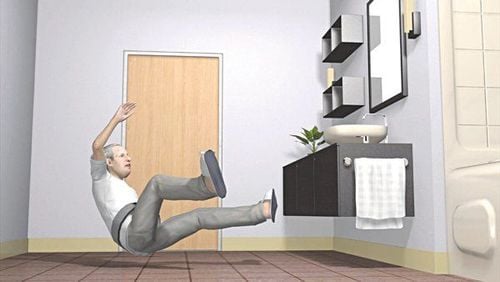This is an automatically translated article.
Posted by Specialist I Vo Khac Khoi Nguyen - Orthopedic Trauma Doctor - General Surgery Department - Vinmec Central Park International General Hospital
Falls are a major health event for older adults, leading to disability and even death. The main risk factors associated with falls include high blood pressure, diabetes, pain, and multiple comorbidities. Older people with type 2 diabetes have a higher risk of falling than healthy people of the same age.
In people with diabetes, in addition to age and comorbidities, it is the loss of musculoskeletal strength, impaired sensory perception and balance due to peripheral neuropathy along with impaired cognitive function leading to an increased risk of falls.
1. Neurological causes of diabetes
At all ages, the rate of falls and fractures in patients with diabetes increases. It is largely due to autonomic neuropathy that causes decreased sensory perception and balance. 50% of people with type 2 diabetes have neuropathy, leading to reduced life expectancy and quality of life. Furthermore, sensory deficits in the feet are associated with altered postural movements and slower gait. This adverse effect on gait is another important mechanism of falls. However, the association between diabetic neuropathy and falls may be even greater in people with impaired sense of joint positioning. In a study of patients with diabetic neuropathy diagnosed by clinical and electrophysiological evaluation: 85% had decreased vibration sensation, 70% had no ankle reflex, and only 39.6% Decreased sensation of locating joints. Decreased sense of joint position was defined as two or more errors in a ten toe position test. Decreased joint position sensation indicates sensory impairment and often occurs in conjunction with muscle atrophy. This suggests an association of diabetic polyneuropathy with falls and fractures. In addition, patients with symptomatic diabetic neuropathy are more likely to be taking medication with a sedative effect, which in turn increases the risk of falls.

2. Causes of low blood sugar, low blood pressure
The use of insulin increases the risk of falls by 94%. This may be due to hypoglycemia but the association may be due to other mechanisms. Use of insulin is considered an indicator of the severity of diabetes. Since insulin is the most important risk factor for hypoglycemia, it may account for the increased risk of falls. In addition, falls associated with hypoglycemia were 70% more likely to lead to fractures, more likely to require emergency room visits, hospitalization, and long-term care.
In addition to hypoglycemia, patients with diabetes often have concomitant hypertension. Changes in blood pressure can cause dizziness, loss of balance, and falls. Medications to treat high blood pressure, diuretics also have a risk of falling. Certain pain relievers, muscle relaxants, and tranquilizers increase the risk of falls.

3. Causes of muscle mass decline
Hypogonadism, aging and diabetes all lead to loss of muscle mass, loss of muscle strength and function. Elderly patients with type 2 diabetes experienced a 37% increase in muscle mass loss compared with those without diabetes.
Decreased muscle mass is a progressive musculoskeletal disorder characterized by decreased muscle mass and strength with decreased physical activity. This condition is caused by degeneration at the neuromuscular junction and loss of motor units. It is also associated with increased muscle breakdown, insulin resistance, increased inflammation, and oxidative stress. Clinically, the patient has symptoms of anorexia and malnutrition. Loss of muscle mass is also associated with an increased rate of slow to rapid muscle twitching. The phenomenon of muscle twitching in the elderly is often unintentional, the muscle twitching occurs in a short time. Muscle twitching adds to the loss of strength and reduces the ability to regain balance while moving.
In summary, patients with diabetes are at high risk of falls. Causes of falls in diabetics can be attributed to decreased muscle mass, hypoglycemia, hypotension, analgesics, and peripheral polyneuritis. Falls are an important health event for people with diabetes, especially as they age. It is this event that can increase the risk of disability and death in patients.

To help patients control their diabetes well, now, Vinmec International General Hospital has a diabetes and hyperlipidemia outpatient management package. Customers can choose to monitor and control blood sugar levels and recognize the risk of possible complications early. Because people with a history of diabetes often have a higher risk of musculoskeletal injuries and have a higher risk of falling than the general population.
Please dial HOTLINE for more information or register for an appointment HERE. Download MyVinmec app to make appointments faster and to manage your bookings easily.














